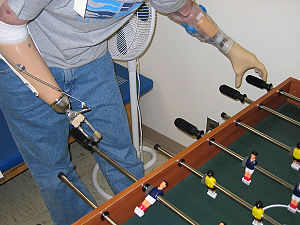Prosthesis

In medicine, a prosthesis (plural prostheses) is an artificial extension that replaces a missing body part. It is part of the field of biomechatronics, the science of fusing mechanical devices with human muscle, skeleton, and nervous systems to assist or enhance motor control lost by trauma, disease, or defect. Prostheses are typically used to replace parts lost by injury (traumatic) or missing from birth (congenital) or to supplement defective body parts. In addition to the standard artificial limb for every-day use, many amputees have special limbs and devices to aid in the participation of sports and recreational activities.
Contents |
Mechanical and electronic components

In order for a robotic prosthetic limb to work, it must have several components to integrate it into the body's function:
Biosensors detect signals from the users nervous or muscular systems. It then relays this information to a controller located inside the device, and processes feedback from the limb and actuator (e.g., position, force) and sends it to the controller. Examples include wires that detect electrical activity on the skin, needle electrodes implanted in muscle, or solid-state electrode arrays with nerves growing through them.
Mechanical sensors process aspects affecting the device (e.g., limb position, applied force, load) and relay this information to the biosensor or controller. Examples: force meters and accelerometers.
The controller is connected to the user's nerve and muscular systems and the device itself. It sends intention commands from the user to the actuators of the device, and interprets feedback from the mechanical and biosensors to the user. The controller is also responsible for the monitoring and control of the movements of the device.
An actuator mimics the actions of a muscle in producing force and movement. Examples include a motor that aids or replaces original muscle tissue.
Cosmesis
With advances in modern tech of cosmesis, the creation of life-like limbs made from silicone or PVC, has been made possible. Such prosthetics, such as artificial hands, can now be made to mimic the appearance of real hands, complete with freckles, veins, hair, fingerprints and even tattoos. Custom-made cosmeses are generally more expensive (costing thousands of US dollars, depending on the level of detail), while standard cosmeses come ready-made in various sizes, though they are often not as realistic as their custom-made counterparts. Another option is the custom-made silicone cover, which can be made to match a person's skin tone but not details such as freckles or wrinkles. Cosmeses are attached to the body in any number of ways, using an adhesive, suction, form-fitting, stretchable skin, or a skin sleeve.
Cognition
Unlike neuromotor prostheses, neurocognitive prostheses would sense or modulate neural function in order to physically reconstitute or augment cognitive processes such as executive function, attention, language, and memory. No neurocognitive prostheses are currently available but the development of implantable neurocognitive brain-computer interfaces has been proposed to help treat conditions such as stroke, traumatic brain injury, cerebral palsy, autism, and Alzheimer's disease.[1]
Prosthetic enhancement
Within science fiction, and, more recently, within the scientific community, there has been consideration given to using advanced prostheses to replace healthy body parts with artificial mechanisms and systems to improve function. The morality and desirability of such technologies is being debated. Body parts such as legs, arms, hands, feet, and others can be replaced.
The first experiment with a healthy individual appears to have been that by the British scientist Kevin Warwick. On 2002-03-14 an implant was interfaced directly into Warwick's nervous system. The electrode array, which contained around 100 electrodes, was placed in the median nerve. The signals produced were detailed enough that a robot arm was able to mimic the actions of Warwick's own arm and provide a form of touch feedback again via the implant.[2]
See also
- Prosthetist
- Amputation
References
- ↑ Serruya MD, Kahana MJ (2008). "Techniques and devices to restore cognition". Behav Brain Res. doi:. PMID 18539345.
- ↑ Warwick,K, Gasson,M, Hutt,B, Goodhew,I, Kyberd,P, Andrews,B, Teddy,P and Shad,A. “The Application of Implant Technology for Cybernetic Systems”, Archives of Neurology, 60(10), pp1369-1373, 2003
External links
- Orthotics & Prosthetics Pakistan First online web resource in Orthotics and Prosthetics from Pakistan.
- The International Society for Prosthetics & Orthotics is an international multi-disciplinary society that is comprised of persons who have a professional interest in the clinical, educational and research aspects of prosthetics, orthotics, rehabilitation engineering and related areas.
- American Academy of Orthotists and Prosthetists is a national organization of practitioners and related O&P professionals.
- Board for Orthotist/Prosthetist Certification, Inc is the National certifying and accrediting body also for orthotic and prosthetic professions.
- American Board for Certification in Orthotics and Prosthetics, Inc is the national certifying and accrediting body for the orthotic and prosthetic professions.
- Amputee Coalition of America has many articles on prosthetics and choosing an O&P provider
- Knee Replacement Surgery
- Never Been Done — Documentary about an athlete with a prosthetic leg
- National Amputee Centre — Information about artificial limbs
- The UMC St Radboud Amputee Team Website - Information for lower limb amputees including prosthesis alignment, tuning and socket design
- O&PCare has a complete glossary relating to the field of prosthetics
- The Open Prosthetics Project - an open-source collaboration between users, designers and funders to make prosthetic design available and affordable
- How Stuff Works : Biomechatronics - an overview of the field of biomechatronics, of which prosthetics is a part]
- The practical side of living a prosthesis. My experiences and other help
- Mind controlled Human Limbs
- Hanger Prosthetics & Orthotics, Inc. Largest provider of prosthetic and orthotic care in the world.